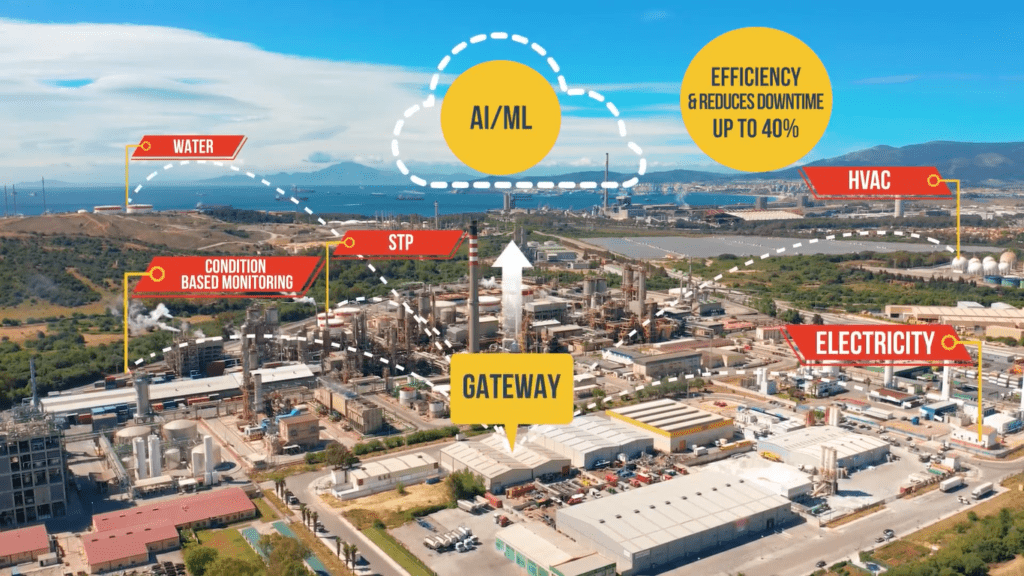Every firm needs to run more efficiently, whether to combat business costs or determine and control potential equipment failures before they happen. Industrial remote monitoring can help. With remote monitoring, your industrial operation can have visions at the most remote places without sending a person manual to those sites for every issue, large or small.
Improving operational efficiency, Cost savings, security, and process quality. These are just a few driving factors after the move to industrial remote monitoring in many industrial operations. In this blog post, we cover the different types of monitoring and how they support a more robust enterprise with better outcomes.
What is industrial remote monitoring?
Industrial remote monitoring is a system that allows real-time monitoring of industrial equipment and processes from a remote location. It uses various technologies such as sensors, data communication networks, and software applications to monitor and control industrial operations continuously.
The main goal is to improve the efficiency and productivity of industrial processes by providing real-time information on the performance of machines and equipment. By monitoring KPIs such as temperature, pressure, and flow rates, operators can identify potential issues before they become critical and take corrective actions to avoid downtime and reduce maintenance costs.
Industrial remote monitoring systems are used in various industries, including manufacturing, energy, and utilities. They can monitor anything from a single machine to an entire plant or production line. They can provide insights into energy consumption, equipment utilization, and maintenance requirements.
Overall, it offers many benefits, including increased efficiency, reduced downtime, and improved safety, making them essential tools for modern industrial operations.

Types of Industrial Remote monitoring
Several industrial remote monitoring systems are designed for specific applications and environments. Here are some of the most common types:
Condition Monitoring: This remote monitoring system tracks the performance of machines and equipment in real time, identifying potential issues before they become critical. It uses various sensors, such as vibration, temperature, and pressure sensors, to monitor the condition of equipment and detect anomalies.
Energy Monitoring: It tracks energy consumption in industrial processes and identifies areas for improvement. It uses various sensors and meters to monitor energy use and identify opportunities for energy savings.
Environmental Monitoring: This monitoring system tracks ecological factors, such as temperature, humidity, and air quality, in industrial environments. It helps to ensure compliance with environmental regulations and identify potential health and safety risks for workers.
Asset Tracking: it refers to tracking the location and status of assets, such as machinery, vehicles, and tools, in real time. It helps businesses to optimize asset utilization and prevent theft or loss of valuable assets.
Process Monitoring: It monitors the performance of industrial processes, such as manufacturing, production, and assembly lines, and helps to identify bottlenecks, optimize workflows, and improve overall efficiency.
Predictive Maintenance – uses machine learning algorithms and predictive analytics to forecast when Maintenance is required for equipment. It helps businesses to minimize downtime and reduce maintenance costs by performing Maintenance only when necessary.
Quality Control: Tracks the quality of products as they move through the manufacturing process, using sensors and cameras to detect defects and deviations from standards. It helps businesses to improve product quality, reduce waste, and increase customer satisfaction.
Supply Chain Monitoring: observe the movement of goods and materials through the supply chain, providing real-time visibility into inventory levels, shipping times, and other critical metrics. It helps businesses to optimize their supply chain operations and improve customer service.
Remote Diagnostics: Allows technicians to diagnose and troubleshoot equipment issues remotely, using sensors and other diagnostic tools to identify the root cause of problems. It helps businesses to reduce downtime, minimize service calls, and improve customer satisfaction.
Business Benefits of Industrial Remote Monitoring
Maximize ROI
Ultimately, every investment decision comes down to understanding the return. How long will it take to realize a return on investment? Is the investment going to benefit my customers? What happens if I decide not to invest? These are some of the questions businesses ask when evaluating an investment in new technology.
As industrial enterprises consider investing in an industrial remote monitoring system, they often find multiple cost-saving and environmental benefits.
Consider how these systems can improve your ROI when deciding on an industrial remote monitoring investment.
- Lower operating costs — The cost of manually managing IoT devices without a system can quickly overtake the price of a remote equipment monitoring system
- Scale without adding staff — Whether you are short-staffed or budget-constrained, industrial remote monitoring automation can reduce the need for hiring extra staff.
- Prove regulatory compliance to avoid fines — Monitoring systems collect and manage data to prove your plans follow regulatory requirements.
Oversee Quality
The quality of your industrial processes directly affects your operations and output since everything from air temperature to machine health and cybersecurity can affect your strategies. If industrial processes form the core of your business, you cannot afford to compromise on quality. With industrial remote process monitoring, hardware and software work together to track production. Operators receive alerts when something changes.
Three critical capabilities of industrial remote monitoring that can benefit your business:
- Proactively manage processes automatically — Receive alerts when monitored metrics change.
- Identify root causes quickly — Identify quality issues before they impact production.
- Predict breakdowns before they occur — Analyze quality data over time to predict future breakdowns.
Optimize Performance
How do you currently optimize the performance of your systems? For your operations, proactive performance monitoring can reduce downtime and lost productivity. With industrial remote monitoring, sensors connected to your machines share large volumes of real-time data. Machine operators enjoy the convenience of getting performance insights remotely from any device. Remote monitoring also helps maximize uptime while minimizing maintenance costs.
Optimizing performance through an industrial remote monitoring system means your operators can:
- Control processes from anywhere
- Get real-time insights into the health of your operations.
- Use predictive maintenance alerts to schedule repairs proactively.
Ensure Safety
Your workforce is the lifeblood of your organization. Technology helps people do their jobs better, gain deeper insights, and find opportunities to add value. The most crucial role of technology in the industrial space is to ensure safety.
Industrial remote monitoring significantly improves operational safety by enabling industrial outfits to gain visibility into their systems and processes anywhere — whether those processes occur deep inside a mine, at the top of a light pole, at a remote wellhead, or in an underground water system. Whether the site presents hazards based on location, hazardous substances, or conditions, gaining insights from those systems via an IoT-based monitoring system can protect your personnel.
How Industrial Remote Monitoring Systems Ensure Safety
- Reduces risk by automating routine maintenance tasks — Automating inspections in hazardous locations reduces injury risk
- Free your team to address Maintenance proactively — Urgent emergency repairs can lead to injury when workers don’t have time to plan
- Safety benefits offset the investment — Investing in monitoring systems improves worker safety is an investment in your people.
Industrial Remote Monitoring Use Case Examples
Industrial remote monitoring uses hardware and software tools to manage industrial processes. These tools create efficiencies and insights not possible with manual processes.
Water management: monitors water usage and distribution, allowing utility companies to identify and address leaks, pressure drops, and flow disruptions. By monitoring water infrastructure in real time, utility companies can reduce water waste, improve sustainability, and avoid costly infrastructure damage.
Energy monitoring :It can track energy usage in real-time, allowing organizations to identify opportunities for energy savings and reduce energy waste. By monitoring energy usage in real-time, organizations can adjust their energy consumption to optimize efficiency and reduce costs.
Asset and Inventory Monitoring : Tracking assets and inventory remotely with IoT technology is a game changer. Asset tracking helps companies check on high-value equipment in real-time. Any industry that manages lots of gear can track inventory location and condition. In real-time, managers can gain perspectives on equipment health, asset loss, or poor operator handling.
As your organization deals with economic and talent pressures, industrial remote monitoring can help. A secure, end-to-end solution can transform your business — for your employees and customers. In this blog post, we’ve shared the excellent benefits and use cases for various types of industrial remote monitoring.
BridgeThings has over years of experience designing and implementing mission-critical connectivity. We have the expertise in wireless technologies to help companies successfully navigate industrial communications challenges.


